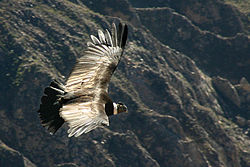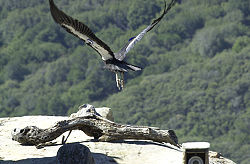Condor
Condor is the name for two species of New World vultures. Each is the only species in its genus. They are the largest flying land birds in the Western Hemisphere. They are:
- The Andean Condor (Vultur gryphus), which lives over the Andes.
- The California Condor (Gymnogyps californianus), now found only on the western coastal mountains of the United States and Mexico.
| Condors | |
|---|---|

| |
| An Andean Condor soars over southern Peru's Colca Canyon. | |
| Scientific classification | |
| Kingdom: | |
| Phylum: | |
| Class: | |
| Order: | |
| Family: | |
Condors are part of the family Cathartidae, whereas the 15 species of Old World vultures are in the family Accipitridae, that also includes falcons, hawks, and eagles. The New World and Old World vultures evolved from different ancestors.
Condors are scavengers. They feed on carrion (dead animals). Their distinctive bare heads are an adaptation to their feeding method. It helps to keep them clean as they feed inside a carcass.
The Andean Condor has a wingspan of between 274 and 310 cm, and weights around 11–15 kg. The California Condor is smaller.
Fossil record
Fossils from the Pleistocene era have been found in various parts of North America, including New York and Florida. California Condors or their ancestors once lived on the west coast of North America as well as all the way to the eastern coast. An ancient relative of the condor, Argentavis magnificens from South America, may have been the largest flying bird ever with a wingspan of 7 metres (23 ft).[1]
Condor Media
The king vulture has close affinities with condors
†Gymnogyps kofordi fossil skull cast, a species from Pleistocene Florida
Numbered condor in Grand Canyon, Arizona
Moche condor. 300 AD. Larco Museum Collection Lima, Peru.
References
- ↑ Campbel K.E. & Tonni E.P. 1983. Size and locomotion in teratorns (Aves: Teratornithidae). Auk 100(2): 390-403
Other websites
| Wikispecies has information on: Vultur. |
- Andean Condor postage stamps Archived 2019-08-01 at the Wayback Machine
- Californian Condor stamps Archived 2014-07-15 at the Wayback Machine
| Wikimedia Commons has media related to Lua error in Module:Commons_link at line 62: attempt to index field 'wikibase' (a nil value).. |
| Wikimedia Commons has media related to Lua error in Module:Commons_link at line 62: attempt to index field 'wikibase' (a nil value).. |







